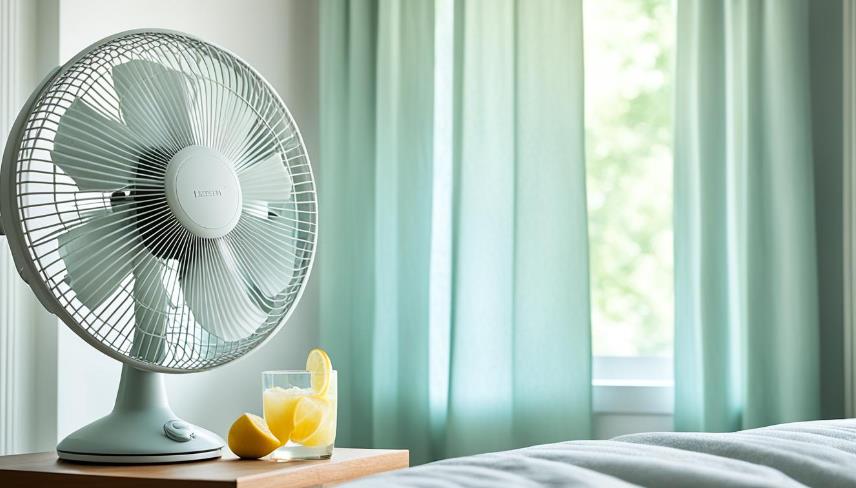Beat the heat with these nine essential tips to cool down your room this summer! Discover how to lower the temperature by up to 20 degrees Fahrenheit, turning your space into a refreshing oasis. From managing sunlight to optimizing airflow, these practical solutions will transform your room into a comfortable haven on scorching hot days. Say goodbye to sweating and hello to relief with these effective cooling strategies. Keep reading to create a cool and enjoyable environment for yourself and your loved ones!
Preventive Measures to Keep Your Room Cool
When the scorching heat of summer arrives, it’s essential to take preventive measures to keep your house cool. By implementing these simple strategies, you can create a more comfortable and cooler environment inside your home.
Let’s explore some effective tips for a cooler home:
1. Close your drapes or blinds.
Closing your drapes or blinds during the hottest parts of the day is an easy way to prevent heat from entering your home. By blocking out sunlight, you can keep the temperature inside cooler and more manageable. This small adjustment can make a big difference in creating a comfortable living space during the sweltering summer months. Plus, it can also help you save on energy costs by reducing the need for air conditioning.
2. Add a window film.
Consider adding a window film to your windows to further reduce heat penetration. These films not only help keep your home cooler but also offer added benefits such as improved privacy and reduced glare. They are easy to install and come in a variety of styles to suit your needs. Additionally, window films can help protect your furniture and flooring from fading due to UV rays, making them a practical and cost-effective solution for a more comfortable home.
3. Keep the stove turned off.
Cooking on a hot stove can significantly increase the temperature in your home, making it less comfortable during the summer months. Instead, consider using alternative cooking methods like grilling outdoors or preparing meals that don’t require the use of the stove, such as salads or sandwiches. These cooler cooking methods can help you maintain a more comfortable indoor temperature and reduce the need for air conditioning. Plus, they can also be a fun and enjoyable way to take advantage of the warmer weather.
4. Turn off (and unplug) unnecessary appliances.
Appliances generate heat, even when they’re not in use. To keep your house cool, make it a habit to turn off and unplug unnecessary appliances. This not only reduces heat emission but also helps save energy. Additionally, consider using energy-efficient appliances that produce less heat. Another tip is to use a power strip to easily turn off multiple devices at once when they’re not in use. Lastly, consider cooking outdoors on hot days to avoid adding extra heat to your home.
5. Add shade outside your home.

Creating shade outside your home can significantly reduce the amount of heat that enters your house. Consider installing awnings, planting trees, or using outdoor shades to block the sun’s rays. By doing so, you can keep the temperature inside cooler and more comfortable. Additionally, shading outdoor air conditioning units can improve their efficiency, helping them cool your home more effectively. Don’t forget to stay hydrated and use fans to circulate air for added comfort!
6. Close the doors to unused rooms.
Don’t waste cool air by allowing it to escape into unused rooms. Close the doors to these rooms to maximize the cooling in the areas you’re actually using. By creating smaller zones, you can focus on cooling the spaces that matter most. Additionally, consider using a portable fan to help circulate cool air more efficiently in the rooms you are using. This simple step can make a noticeable difference in maintaining a comfortable temperature throughout your home. Finally, sealing any gaps around windows and doors can prevent cool air from escaping and warm air from entering, further improving the efficiency of your cooling efforts
7. Close gaps around your doors and windows.
Gaps around doors and windows can let cool air escape and hot air enter your home. Seal these gaps using weatherstripping or caulking to prevent unwanted heat transfer. This simple step can make a significant difference in maintaining a cool indoor environment. Additionally, consider installing door sweeps to further prevent air leakage. Don’t forget to check and maintain the seals on your windows to ensure they are in good condition. Lastly, using draft stoppers at the base of doors can also help prevent heat from entering your home.
8. Use LED lightbulbs.
LED lightbulbs not only consume less energy but also emit less heat compared to traditional incandescent bulbs. By replacing your old bulbs with LEDs, you can reduce both your energy usage and the heat generated, helping to keep your house cool. LEDs produce light through a process that generates significantly less heat than incandescent bulbs, which convert a large portion of energy into heat. This means that not only do LEDs save energy, but they also contribute less to the overall heat load in your home. Additionally, LED bulbs have a longer lifespan than incandescent bulbs, reducing the need for frequent replacements and further lowering your environmental impact.
9. Run a ceiling fan.
A ceiling fan can effectively circulate air in your home, creating a cooling breeze that helps lower the perceived temperature. Running your ceiling fan counterclockwise during the summer maximizes its cooling effect by creating a wind-chill breeze effect. This effect helps evaporate moisture from your skin, making you feel cooler. Additionally, circulating air can prevent the buildup of hot air near the ceiling, keeping the room more evenly cooled. Remember to adjust the fan speed based on your comfort level and to turn it off when you leave the room to save energy.
10. Use a dehumidifier

High humidity can make a hot room feel even more unbearable because moisture in the air makes it harder for sweat to evaporate from your skin, which is your body’s way of cooling down. By using a dehumidifier, you can reduce the moisture in the air, making the environment feel cooler and more comfortable. This is because lower humidity levels allow sweat to evaporate more easily, helping your body cool down more efficiently. Place the dehumidifier in areas with high humidity levels, such as basements or bathrooms, to effectively reduce humidity and improve comfort. Additionally, lower humidity levels can also help prevent the growth of mold and mildew, which thrive in damp environments, improving air quality in your home.
11. Chill the air with DIY methods.
There are several DIY methods you can try to cool the air in your house. For example, you can place bowls of ice in front of fans to create a refreshing breeze or use a damp towel to cool yourself down. These simple techniques can provide instant relief from the heat.
Implementing these preventive measures for cooling can help you maintain a more comfortable and cooler home during the summer months. By following these tips and techniques, you can beat the heat and create the perfect oasis inside your house.
Using Air Conditioner and the Best Brands in US
Using an air conditioner effectively can greatly improve your comfort during hot days. Understanding how to operate it efficiently and choosing a reliable brand are key. Start by setting the temperature between 72 to 78 degrees Fahrenheit for optimal comfort and energy efficiency. Avoid frequent adjustments, as this can increase energy consumption. By following these tips and selecting a reputable brand, you can create a cool and comfortable environment in your room all summer long.
Additionally, make sure to maintain your air conditioner by regularly cleaning or replacing the filters. Dirty filters can obstruct airflow, reducing the cooling efficiency of your unit. Clean filters not only enhance the overall performance but also help promote better indoor air quality. Refer to the manufacturer’s instructions for the recommended frequency of filter maintenance.
When selecting an air conditioner brand, consider reputable options known for their quality and reliability. Some of the best brands available in the US include Carrier, Lennox, Trane, and Goodman. These brands offer a range of models with various features and capacities, allowing you to choose one that suits your specific cooling needs. Look for energy-efficient models with high SEER (Seasonal Energy Efficiency Ratio) ratings to reduce energy consumption and save on utility bills over time.
FAQs on How to Cool Down a Room
How can I keep my bedroom cool without AC?
There are several ways to cool your bedroom without the use of an air conditioner. Some effective methods include closing your drapes or blinds, adding a window film, keeping the stove turned off, turning off unnecessary appliances, adding shade outside your home, closing the doors to unused rooms, closing gaps around your doors and windows, using LED lightbulbs, running a ceiling fan, using a dehumidifier, and chilling the air with DIY methods.
How do I cool down a room quickly?
To cool down a room quickly, you can try the following techniques: close your doors and windows to prevent warm air from entering, turn off unnecessary appliances and lights, use a fan to circulate the air, place a bowl of ice or a wet towel in front of the fan to create a cooling effect, and open doors and windows during cooler evenings to let fresh air in.
Does putting ice in front of a fan work?
Putting ice in front of a fan can help create a cooling effect in a room, especially if the fan is positioned correctly. The ice cools the air as it passes over it, providing a refreshing breeze. However, keep in mind that this method may not be as effective as using an air conditioner, and the cooling effect will be temporary. It can be a helpful DIY solution for providing temporary relief in a hot room.

